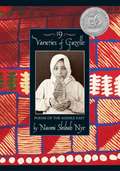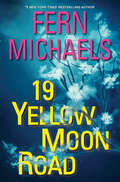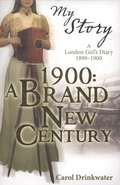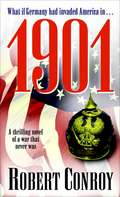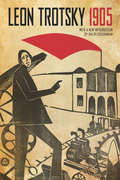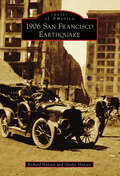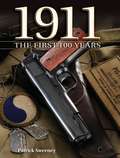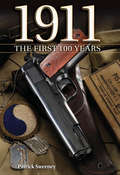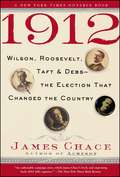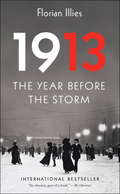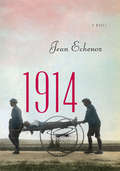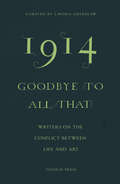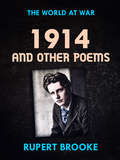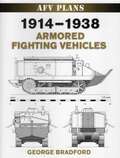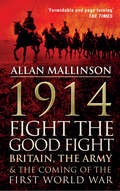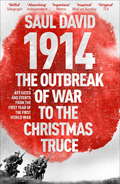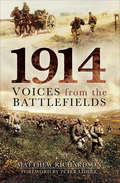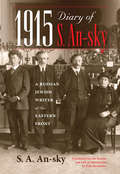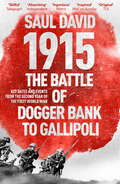- Table View
- List View
19 Varieties of Gazelle: Poems of the Middle East
by Naomi Shihab Nye"Tell me how to live so many lives at once ..."<p> Fowzi, who beats everyone at dominoes; Ibtisam, who wanted to be a doctor; Abu Mahmoud, who knows every eggplant and peach in his West Bank garden; mysterious Uncle Mohammed, who moved to the mountain; a girl in a red sweater dangling a book bag; children in velvet dresses who haunt the candy bowl at the party; Baba Kamalyari, age 71; Mr. Dajani and his swans; Sitti Khadra, who never lost her peace inside.<p> Maybe they have something to tell us.<p> Naomi Shihab Nye has been writing about being Arab-American, about Jerusalem, about the West Bank, about family all her life. These new and collected poems of the Middle East -- sixty in all -- appear together here for the first time.
19 Yellow Moon Road: An Action-Packed Novel of Suspense (Sisterhood #33)
by Fern MichaelsA thrilling new book in the wildly popular series from the author of Hidden, legendary #1 New York Times bestseller Fern Michaels! The Sisterhood is reuniting to investigate The Haven, a suspicious spiritual organization that&’s more dangerous cult than caring commune… Maggie Spritzer&’s nose for a story doesn&’t just make her a top-notch newspaper editor, it also tells her when to go the extra mile for a friend. When she gets a strange message from her journalism pal, Gabby Richardson, Maggie knows her services are needed. Gabby has become involved with The Haven, a commune that promises to guide its members toward a more spiritually fulfilling life. But Gabby&’s enthusiasm has turned to distrust ever since she was refused permission to leave the compound to visit her sick mother. Maggie wants to learn more about The Haven, and the Sisterhood is eager to help. It turns out The Haven&’s founders are the sons of a disgraced Chicago businessman in prison for running a Ponzi scheme. They also have connections to a Miami billionaire with dubious sidelines. Soon, the Sisterhood gang embark on a search—and uncover a web of crime that runs deeper and higher than they ever imagined. And they&’ll need all their special skills to bring it down… Praise for Fern Michaels&“Michaels&’s highly developed skills as a storyteller are evident in the affable characters [and] suspenseful plot.&” —Publishers Weekly on Deep Harbor
1900 - A Brand New Century (My Story Series)
by Carol DrinkwaterThe diary of Flora Bonnington, London 1899-1900: 'A day slips away like sand in a sand glass and so we are caught up in this inevitable passage towards 1900. I bought a journal... it will record my journey into the new century. <P><P> I shall call it 'Twentieth Century Girl' for that is what I intend to be'. Flora lives in a world where it is considered unattractive for a lady to express an opinion, but Flora longs to change things: she wants to vote and make sure everyone can have an education. But can she really make a stand against society, and her father? With accurate historical detail.
1901: A Thrilling Novel of a War that Never Was
by Robert ConroyThe year is 1901. Germany's navy is the second largest in the world; their army, the most powerful. But with the exception of a small piece of Africa and a few minor islands in the Pacific, Germany is without an empire. Kaiser Wilhelm II demands that the United States surrender its newly acquired territories: Guam, Puerto Rico, Cuba, and the Philippines. President McKinley indignantly refuses, so with the honor and economic future of the Reich at stake, the Kaiser launches an invasion of the United States, striking first on Long Island. Now the Americans, with their army largely disbanded, must defend the homeland. When McKinley suffers a fatal heart attack, the new commander in chief, Theodore Roosevelt, rallies to the cause, along with Confederate general James Longstreet. From the burning of Manhattan to the climactic Battle of Danbury, American forces face Europe's most potent war machine in a blazing contest of will against strength.
1905
by Leon TrotskyLeon Trotsky's 1905-despite long being out of print-has remained the central point of reference for those looking to understand the rising of workers, peasants, and soldiers that nearly unseated the Tsar in 1905. Trotsky's elegant, beautifully written account draws on his experience as a key leader of the revolution.
1906 San Francisco Earthquake (Images of America)
by Richard Hansen Gladys HansenOne of the greatest disasters of the twentieth century, in words and photos. The Great Earthquake and Fire of 1906 was an unparalleled catastrophe in the history of San Francisco. More than 4.5 square miles of the city burned and crumbled into a windswept desert of desolation. This book is filled with remarkable images, from before the earthquake through the blaze and into the rebuilding. With stories from survivors, and extensive photographs of sites from the waterfront in the east to Golden Gate Park in the west, the marina in the north to the Mission District in the south, readers can gain a vivid sense of this major historical event and how it affected one of America&’s greatest cities.
1910: The Emancipation of Dissonance
by Thomas HarrisonThe year 1910 marks an astonishing, and largely unrecognized, juncture in Western history. In this perceptive interdisciplinary analysis, Thomas Harrison addresses the extraordinary intellectual achievement of the time. Focusing on the cultural climate of Middle Europe and paying particular attention to the life and work of Carlo Michelstaedter, he deftly portrays the reciprocal implications of different discourses—philosophy, literature, sociology, music, and painting. His beautifully balanced and deeply informed study provides a new, wider, and more ambitious definition of expressionism and shows the significance of this movement in shaping the artistic and intellectual mood of the age.1910 probes the recurrent themes and obsessions in the work of intellectuals as diverse as Egon Schiele, Georg Trakl, Vasily Kandinsky, Georg Lukàcs, Georg Simmel, Dino Campana, and Arnold Schoenberg. Together with Michelstaedter, who committed suicide in 1910 at the age of 23, these thinkers shared the essential concerns of expressionism: a sense of irresolvable conflict in human existence, the philosophical status of death, and a quest for the nature of human subjectivity. Expressionism, Harrison argues provocatively, was a last, desperate attempt by the intelligentsia to defend some of the most venerable assumptions of European culture. This ideological desperation, he claims, was more than a spiritual prelude to World War I: it was an unheeded, prophetic critique.
1911 The First 100 Years
by Patrick SweeneyIn 1911, the history of firearms changed forever with the adoption of the greatest pistol ever designed, the Automatic Pistol, Caliber . 45, M1911 - known today simply as the 1911. Now, in one fascinating, illustrated volume, authority Patrick Sweeney celebrates the 100th anniversary of the greatest fighting handgun ever designed, John M. Brownings legendary 1911 . 45. From the predecessors of the 1911 and its contemporaries to the best of today's semi- and -full-custom models, you'll find it in 1911: The First 100 Years. Lavishly illustrated with photographs collected from around the world, 1911: The First 100 Years is a fitting centennial tribute to a pistol that is today more popular than ever. For the collector, for the shooter, for the historian - for anyone interested in big-bore handguns or the evolution of this truly American classic, this is a must-have volume.
1911 The First 100 Years
by Patrick SweeneyIn 1911, the history of firearms changed forever with the adoption of the greatest pistol ever designed, the Automatic Pistol, Caliber .45, M1911--known today simply as the 1911. Now, in one fascinating, illustrated volume, authority Patrick Sweeney celebrates the 100th anniversary of the greatest fighting handgun ever designed, John M. Brownings legendary 1911 .45. From the predecessors of the 1911 and its contemporaries to the best of today's semi- and full-custom models, you'll find it in 1911: The First 100 Years. Lavishly illustrated with photographs collected from around the world, 1911: The First 100 Years is a fitting centennial tribute to a pistol that is today more popular than ever. For the collector, for the shooter, for the historian--for anyone interested in big-bore handguns or the evolution of this truly American classic, this is a must-have volume.
1912
by James ChaceFour extraordinary men sought the presidency in 1912. Theodore Roosevelt was the charismatic and still wildly popular former president who sought to redirect the Republican Party toward a more nationalistic, less materialistic brand of conservatism and the cause of social justice. His handpicked successor and close friend, William Howard Taft, was a reluctant politician whose sole ambition was to sit on the U.S. Supreme Court. Amiable and easygoing, Taft was the very opposite of the restless Roosevelt. After Taft failed to carry forward his predecessor's reformist policies, an embittered Roosevelt decided to challenge Taft for the party's nomination. Thwarted by a convention controlled by Taft, Roosevelt abandoned the GOP and ran in the general election as the candidate of a third party of his own creation, the Bull Moose Progressives.Woodrow Wilson, the former president of Princeton University, astonished everyone by seizing the Democratic nomination from the party bosses who had made him New Jersey's governor. A noted political theorist, he was a relative newcomer to the practice of governing, torn between his fear of radical reform and his belief in limited government. The fourth candidate, labor leader Eugene V. Debs, had run for president on the Socialist ticket twice before. A fervent warrior in the cause of economic justice for the laboring class, he was a force to be reckoned with in the great debate over how to mitigate the excesses of industrial capitalism that was at the heart of the 1912 election.Chace recounts all the excitement and pathos of a singular moment in American history: the crucial primaries, the Republicans' bitter nominating convention that forever split the party, Wilson's stunning victory on the forty-sixth ballot at the Democratic convention, Roosevelt's spectacular coast-to-coast whistle-stop electioneering, Taft's stubborn refusal to fight back against his former mentor, Debs's electrifying campaign appearances, and Wilson's "accidental election" by less than a majority of the popular vote.Had Roosevelt received the Republican nomination, he almost surely would have been elected president once again and the Republicans would likely have become a party of reform. Instead, the GOP passed into the hands of a conservative ascendancy that reached its fullness with Ronald Reagan and George W. Bush, and the party remains to this day riven by the struggle between reform and reaction, isolationism and internationalism. The 1912 presidential contest was the first since the days of Jefferson and Hamilton in which the great question of America's exceptional destiny was debated. 1912 changed America.
1912: The Year the World Discovered Antarctica
by Chris Turney"The South Pole discovered" trumpeted the front page of The Daily Chronicle on March 8, 1912, marking Roald Amundsen's triumph over the tragic Robert Scott. Yet behind all the headlines there was a much bigger story. Antarctica was awash with expeditions. In 1912, five separate teams representing the old and new world were diligently embarking on scientific exploration beyond the edge of the known planet. Their discoveries not only enthralled the world, but changed our understanding of the planet forever. Tales of endurance, self-sacrifice, and technological innovation laid the foundations for modern scientific exploration, and inspired future generations.To celebrate the centenary of this groundbreaking work, 1912: The Year the World Discovered Antarctica revisits the exploits of these different expeditions. Looking beyond the personalities and drawing on his own polar experience, Chris Turney shows how their discoveries marked the dawn of a new age in our understanding of the natural world. He makes use of original and exclusive unpublished archival material and weaves in the latest scientific findings to show how we might reawaken the public's passion for discovery and exploration
1912: Wilson, Roosevelt, Taft & Debs - the Election That Changed the Country
by James Chace Ellen R. SasaharaBeginning with former president Theodore Roosevelt's return in 1910 from his African safari, Chace brilliantly unfolds a dazzling political circus that featured four extraordinary candidates. When Roosevelt failed to defeat his chosen successor, William Howard Taft, for the Republican nomination, he ran as a radical reformer on the Bull Moose ticket. Meanwhile, Woodrow Wilson, the ex-president of Princeton, astonished everyone by seizing the Democratic nomination from the bosses who had made him New Jersey's governor. Most revealing of the reformist spirit sweeping the land was the charismatic socialist Eugene Debs, who polled an unprecedented one million votes. Wilson's "accidental" election had lasting impact on America and the world. The broken friendship between Taft and TR inflicted wounds on the Republican Party that have never healed, and the party passed into the hands of a conservative ascendancy that reached its fullness under Reagan and George W. Bush. Wilson's victory imbued the Democratic Party with a progressive idealism later incarnated in FDR, Truman, and LBJ. 1912 changed America.
1913
by Shaun Whiteside Florian Illies Jamie Lee SearleJust before one of its darkest moments came the twentieth century's most exciting year . . .It was the year Henry Ford first put a conveyer belt in his car factory, and the year Louis Armstrong first picked up a trumpet. It was the year Charlie Chaplin signed his first movie contract, and Coco Chanel and Prada opened their first dress shops. It was the year Proust began his opus, Stravinsky wrote The Rite of Spring, and the first Armory Show in New York introduced the world to Picasso and the world of abstract art. It was the year the recreational drug now known as ecstasy was invented.It was 1913, the year before the world plunged into the catastrophic darkness of World War I.In a witty yet moving narrative that progresses month by month through the year, and is interspersed with numerous photos and documentary artifacts (such as Kafka's love letters), Florian Illies ignores the conventions of the stodgy tome so common in "one year" histories. Forefronting cultural matters as much as politics, he delivers a charming and riveting tale of a world full of hope and unlimited possibility, peopled with amazing characters and radical politics, bristling with new art and new technology . . . even as ominous storm clouds began to gather.From the Hardcover edition.
1913: In Search of the World Before the Great War
by Charles EmmersonToday, 1913 is inevitably viewed through the lens of 1914: as the last year before a war that would shatter the global economic order and tear Europe apart, undermining its global pre-eminence. Our perspectives narrowed by hindsight, the world of that year is reduced to its most frivolous features?last summers in grand aristocratic residences?or its most destructive ones: the unresolved rivalries of the great European powers, the fear of revolution, violence in the Balkans. In this illuminating history, Charles Emmerson liberates the world of 1913 from this ?prelude to warOCO narrative, and explores it as it was, in all its richness and complexity. Traveling from EuropeOCOs capitals, then at the height of their global reach, to the emerging metropolises of Canada and the United States, the imperial cities of Asia and Africa, and the boomtowns of Australia and South America, he provides a panoramic view of a world crackling with possibilities, its future still undecided, its outlook still open. The world in 1913 was more modern than we remember, more similar to our own times than we expect, more globalized than ever before. The Gold Standard underpinned global flows of goods and money, while mass migration reshaped the worldOCOs human geography. Steamships and sub-sea cables encircled the earth, along with new technologies and new ideas. FordOCOs first assembly line cranked to life in 1913 in Detroit. The Woolworth Building went up in New York. While Mexico was in the midst of bloody revolution, Winnipeg and Buenos Aires boomed. An era of petro-geopolitics opened in Iran. China appeared to be awaking from its imperial slumber. Paris celebrated itself as the city of light?Berlin as the city of electricity. Full of fascinating characters, stories, and insights, "1913: In Search of the World before the Great War" brings a lost world vividly back to life, with provocative implications for how we understand our past and how we think about our future.
1914
by Linda Coverdale Jean EchenozFive Frenchmen go off to war, two of them leaving behind a certain young woman who longs for their return. But the main character in 1914 is the Great War itself. Jean Echenoz, the multi-award-winning French literary magician whose work has been compared to Joseph Conrad and Lawrence Sterne, has brought that deathtrap back to life, leading us gently from a balmy summer day deep into the insatiable-and still unthinkable-carnage of trench warfare.With the delicacy of a miniaturist and with irony both witty and clear-eyed, the author offers us an intimate epic with the atmosphere of a classic movie: in the panorama of a clear blue sky, a biplane spirals suddenly into the ground; a tardy piece of shrapnel shears the top off a man's head as if it were a soft-boiled egg; we dawdle dreamily in a spring-scented clearing with a lonely shell-shocked soldier strolling innocently to a firing squad ready to shoot him for desertion.But ultimately, the grace notes of humanity in 1914 rise above the terrors of war in this beautifully crafted tale that Echenoz tells with discretion, precision, and love.
1914 - Goodbye to All That
by Jeanette Winterson Colm Toibin Elif Shafak Erwin Mortier Lawinia GreenlawIn this collection of essays, ten leading writers from different countries consider the conflicts that have informed their own literary lives. 1914-Goodbye to All That borrows its title from Robert Graves's "bitter leave-taking of England" in which he writes not only of the First World War but the questions it raised: how to live, how to live with each other, and how to write. Interpreting this title as broadly and ambiguously as Graves intended, these essays mark the War's centenary by reinvigorating these questions. The book includes Elif Shafak on an inheritance of silence in Turkey, Ali Smith on lost voices in Scotland, Xiaolu Guo on the 100,000 Chinese sent to the Front, Daniel Kehlmann on hypnotism in Berlin, Colm Toibin on Lady Gregory losing her son fighting for Britain as she fought for an independent Ireland, Kamila Shamsie on reimagining Karachi, Erwin Mortier on occupied Belgium's legacy of shame, NoViolet Bulawayo on Zimbabwe and clarity, Ales Steger on resisting history in Slovenia, and Jeanette Winterson on what art is for. Contributors include: Ali Smith - Scotland Ales Steger - Slovenia Jeanette Winterson - England Elif Shafak - Turkey NoViolet Bulawayo - Zimbabwe Colm Toíbín - Ireland Xiaolu Guo - China Erwin Mortier - Belgium Kamila Shamsie - Pakistan Daniel Kehlmann - GermanyFrom the Trade Paperback edition.
1914 and Other Poems (The World At War)
by Rupert BrookeRupert Brooke had planned to put together a second collection of poetry for the spring of 1915. However he died of blood-poisoning while serving in World War I and this collection was published posthumously in 1915. It includes the celebrated poem "The Old Vicarage, Granchester". (Amazon)
1914-1938 Armored Fighting Vehicles (World War II AFV Plans)
by George BradfordGeorge Bradford's latest collection of scale drawings of armored fighting vehicles focuses on the years from World War I to the eve of World War II.
1914: Britain, the Army and the Coming of the First World War
by Allan Mallinson‘No part of the Great War compares in interest with its opening’, wrote Churchill. ‘The measured, silent drawing together of gigantic forces, the uncertainty of their movements and positions, the number of unknown and unknowable facts made the first collision a drama never surpassed…in fact the War was decided in the first twenty days of fighting, and all that happened afterwards consisted in battles which, however formidable and devastating, were but desperate and vain appeals against the decision of fate.’On of Britain's foremost military historians and defence experts tackles the origins - and the opening first few weeks of fighting - of what would become known as 'the war to end all wars'. Intensely researched and convincingly argued, Allan Mallinson explores and explains the grand strategic shift that occurred in the century before the war, the British Army’s regeneration after its drubbings in its fight against the Boer in South Africa, its almost calamitous experience of the first twenty days’ fighting in Flanders to the point at which the British Expeditionary Force - the 'Old Contemptibles' - took up the spade in the middle of September 1914: for it was then that the war changed from one of rapid and brutal movement into the more familiar vision of trench warfare on Western Front. In this vivid, compelling new history, Malliinson brings his experience as a professional soldier to bear on the circumstances, events, actions and individuals and speculates – tantalizingly – on what might have been...
1914: Key Dates and Events from the First Year of the First World War
by Saul DavidThis special ebook has been created by historian Saul David from his acclaimed work 100 Days to Vistory: How the Great War was Fought and Won, which was described by the Mail on Sunday as 'Inspired' and by Charles Spencer as 'A work of great originality and insight'. Through key dates from 4 August 1914, when Britain declared war, to the Christmas Truce of 24 December 1914, Saul David's gripping narrative is an enthralling tribute to a generation of men and women whose sacrifice should never be forgotten.
1914: The Outbreak of War to the Christmas Truce
by Saul DavidThis special ebook has been created by historian Saul David from his acclaimed work 100 Days to Vistory: How the Great War was Fought and Won, which was described by the Mail on Sunday as 'Inspired' and by Charles Spencer as 'A work of great originality and insight'. Through key dates from 4 August 1914, when Britain declared war, to the Christmas Truce of 24 December 1914, Saul David's gripping narrative is an enthralling tribute to a generation of men and women whose sacrifice should never be forgotten.
1914: Voices from the Battlefields
by Matthew RichardsonThe opening battles of WWI&’s Western Front and the world-changing advances in warfare are reexamined through eyewitness accounts from the trenches. The 1914 campaign of World War I, sparked by the German Army&’s invasion of Luxembourg, Belgium, and France, marked a watershed in military history. Advances in weaponry forced both sides to take to the earth in what became a grueling standoff of trench warefare. In a bizarre mix of ancient and modern, some of the last cavalry charges took place in the same theatre in which armoured cars, motorcycles and aeroplanes were beginning to make their presence felt. These dramatic developments were recorded in graphic detail by soldiers who were there in the trenches themselves. Now, with the benefit of these firsthand accounts, historian Matthew Richardson offers a thoroughgoing reassessment of the 1914 campaign. His vivid narrative emphasises the perspective of the private soldiers and junior officers of the British Army and includes full colour plates containing over one hundred illustrations. 1914: Voices from the Battlefields was a Britain At War Magazine Book of the Month in February 2014.
1915 Diary of S. An-sky: A Russian Jewish Writer at the Eastern Front (Encounters: Explorations in Folklore and Ethnomusicology)
by S. A. An-SkyThe WWI diary of the Russian Jewish activist and author of The Dybbuk presents &“an unforgettable portrait of life, culture, and destruction&” (Eugene Avrutin, author of Jews and the Imperial State). By the outbreak of World War I, S. An-sky was a well-known writer, a longtime revolutionary, and an ethnographer who pioneered the collection of Jewish folklore in Russia's Pale of Settlement. In 1915, An-sky took on the assignment of providing aid and relief to Jewish civilians trapped under Russian military occupation in Galicia. As he made his way through the shtetls there, close to the Austrian frontlines, he kept a diary of his encounters and impressions. In his diary, An-sky describes conversations with wounded soldiers in hospitals, fellow Russian and Jewish aid workers, and Jewish civilians living on the Eastern Front. He recorded the brutality and violence against the civilian population, the complexities of interethnic relations, the practices and limitations of philanthropy and medical care, Russification policies, and antisemitism. In the late 1910s, An-sky used his diaries as raw material for a lengthy memoir in Yiddish, published under the title The Destruction of Galicia. Although most of An-sky&’s original diaries were lost, two fragments are preserved in the Russian State Archive of Literature and Art. Translated and annotated here by Polly Zavadivker, these fragments convey An-sky's vivid perceptions and enlightening insights.
1915: Key Dates and Events from the Second Year of the First World War
by Saul DavidThis special ebook has been created by historian Saul David from his acclaimed work 100 Days to Vistory: How the Great War was Fought and Won, which was described by the Mail on Sunday as 'Inspired' and by Charles Spencer as 'A work of great originality and insight'. Through key dates from the Battle of Dogger Bank on 24th January 1914, to the Gallipoli landings, Saul David's gripping narrative is an enthralling tribute to a generation of men and women whose sacrifice should never be forgotten.
1915: The Battle of Dogger Bank to Gallipoli
by Saul DavidThis special ebook has been created by historian Saul David from his acclaimed work 100 Days to Vistory: How the Great War was Fought and Won, which was described by the Mail on Sunday as 'Inspired' and by Charles Spencer as 'A work of great originality and insight'. Through key dates from the Battle of Dogger Bank on 24th January 1914, to the Gallipoli landings, Saul David's gripping narrative is an enthralling tribute to a generation of men and women whose sacrifice should never be forgotten.
